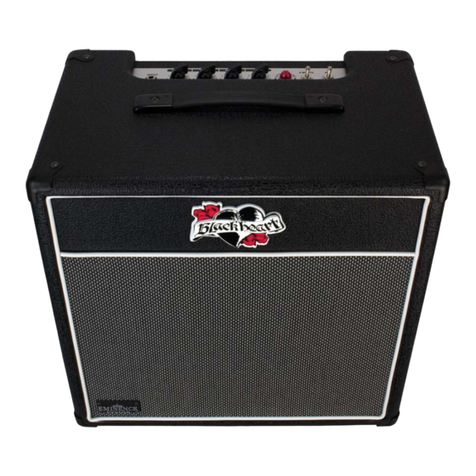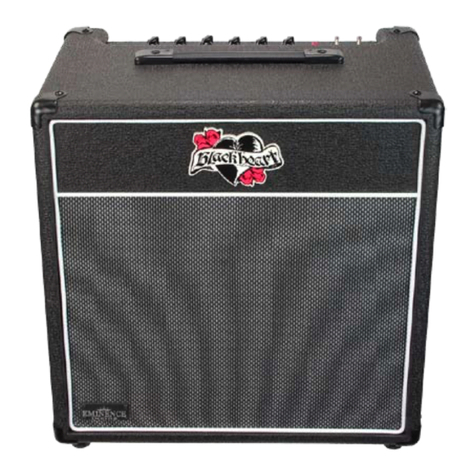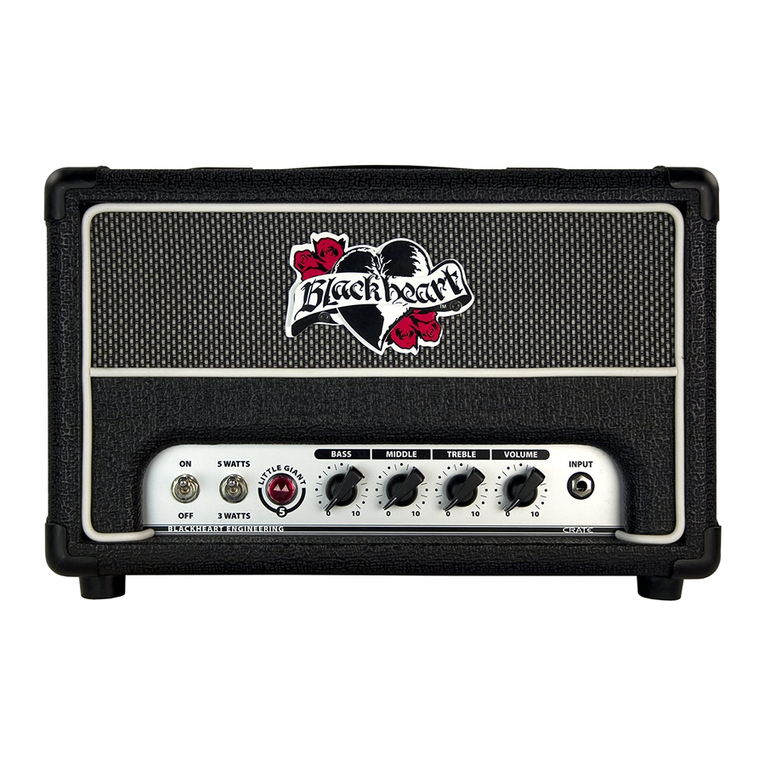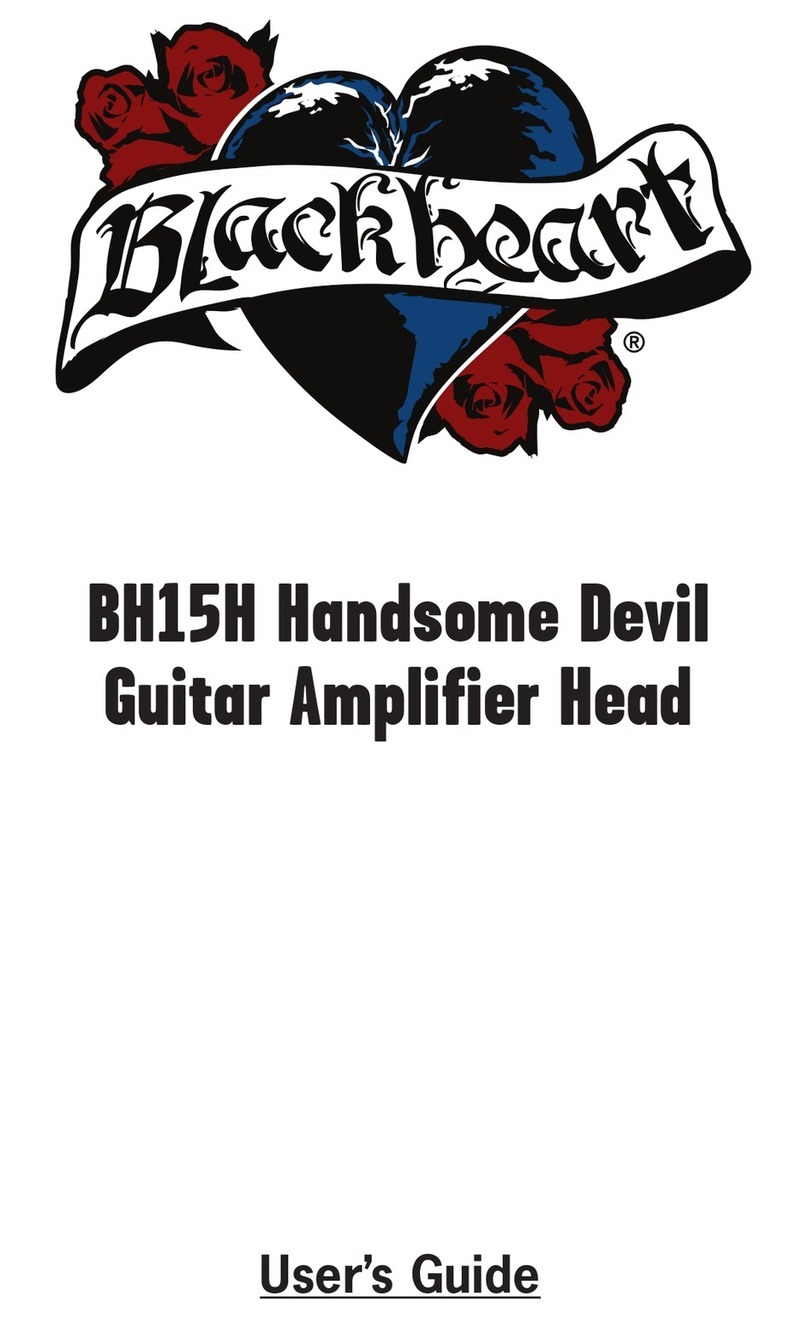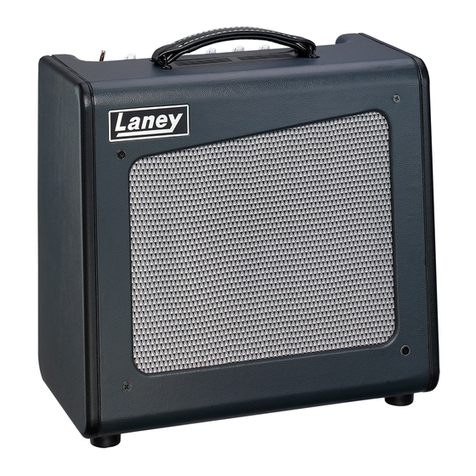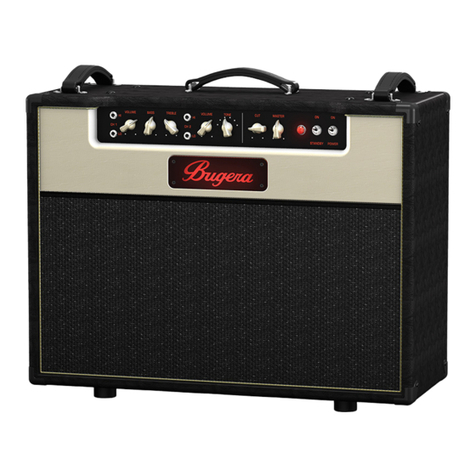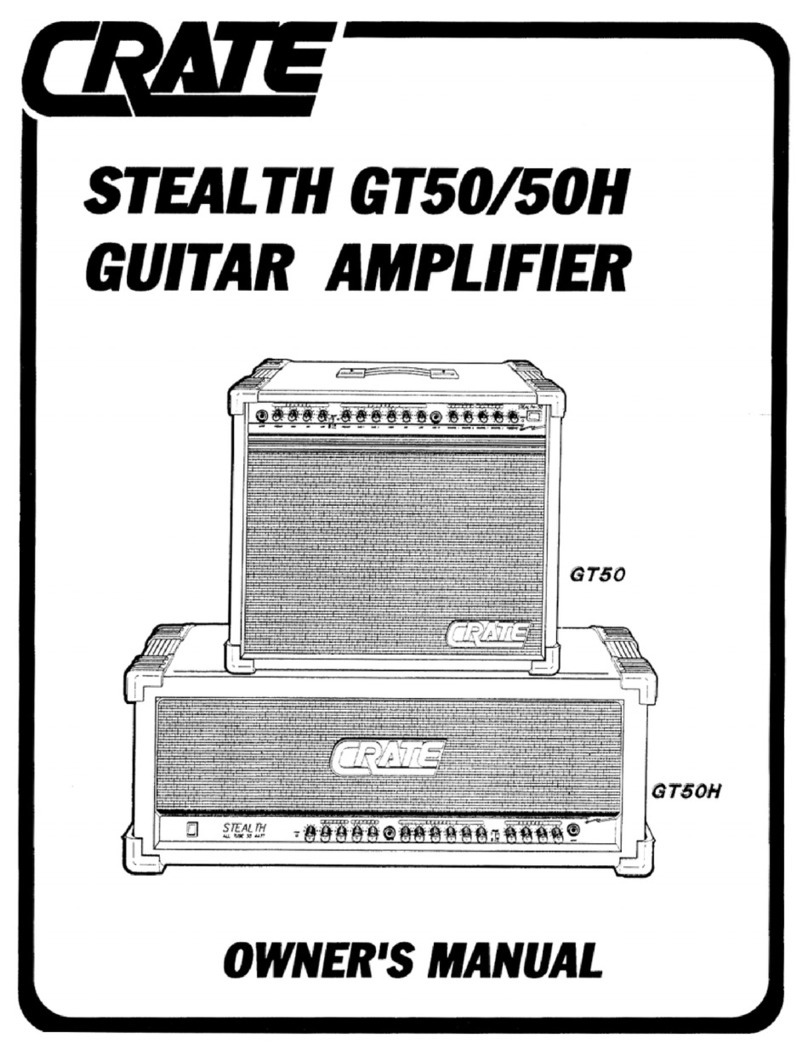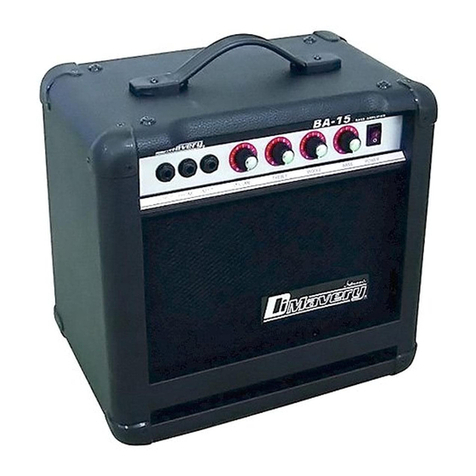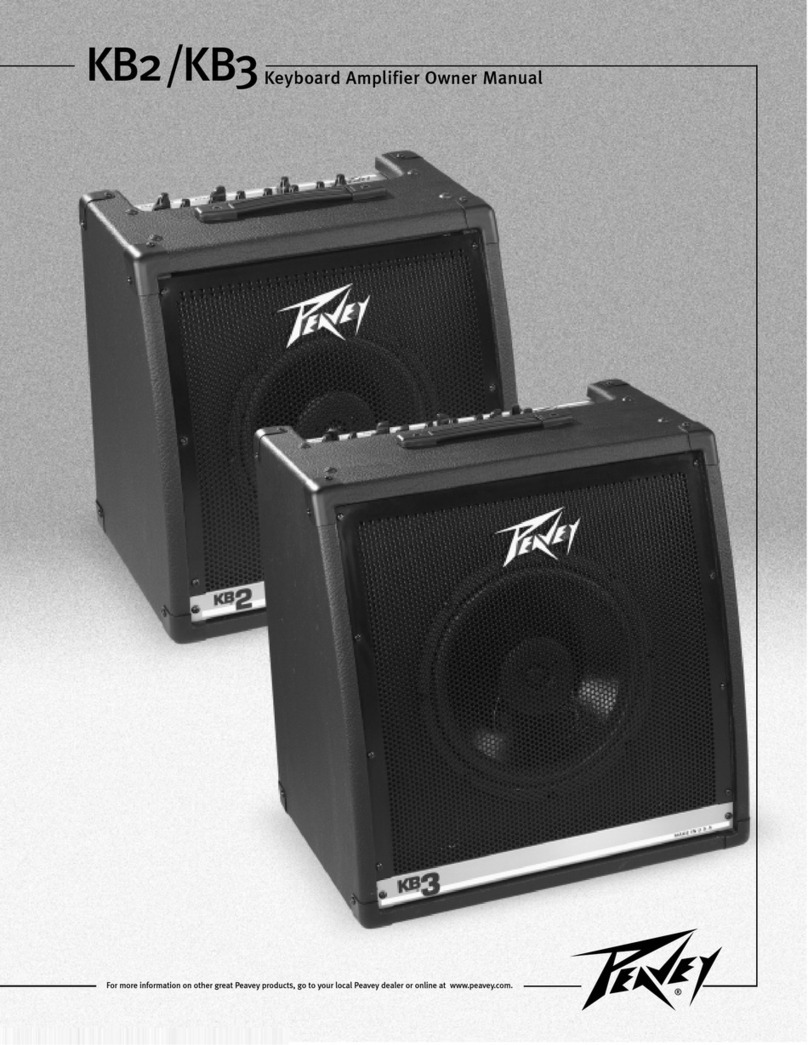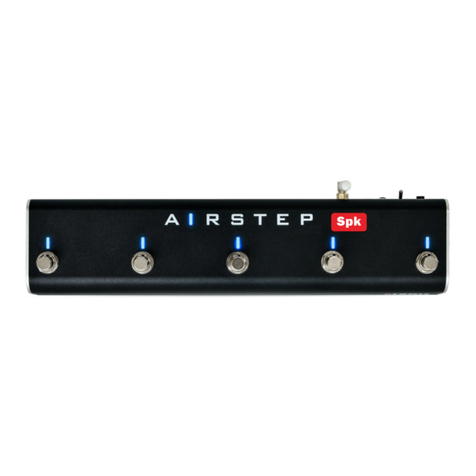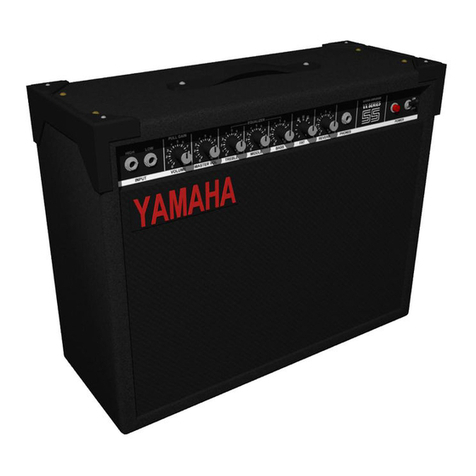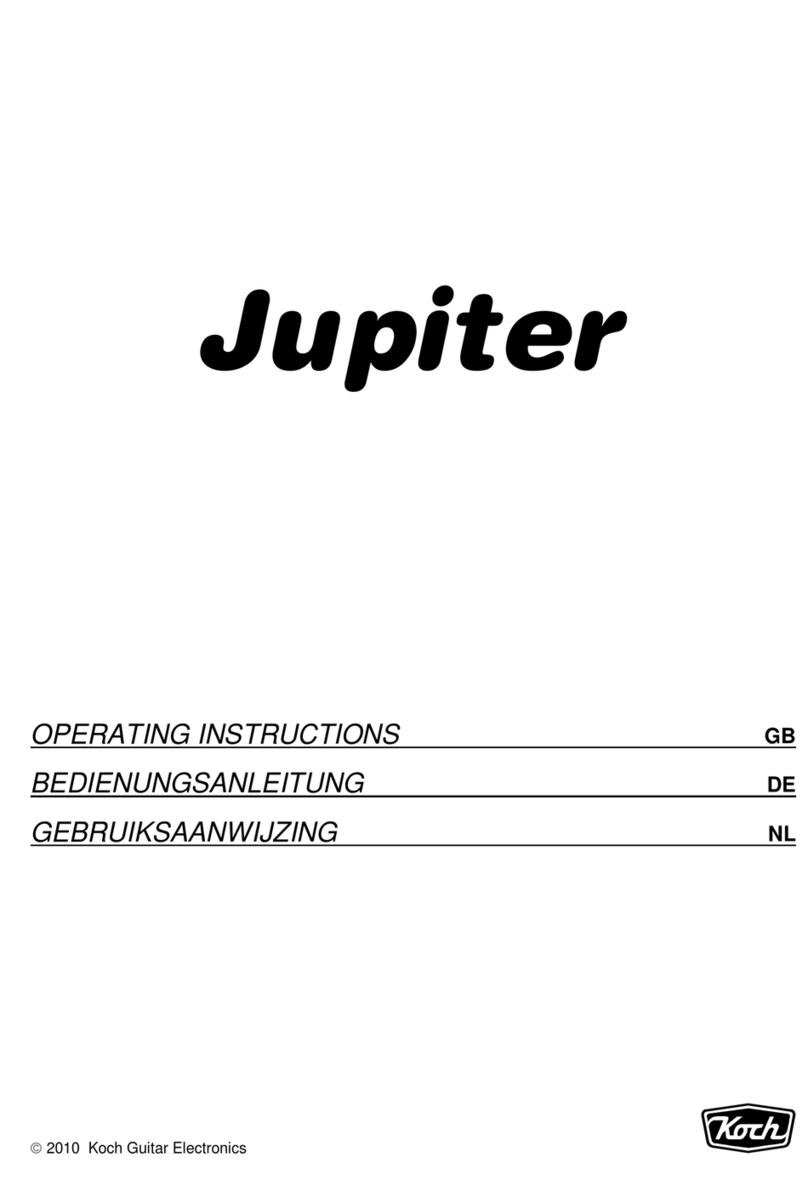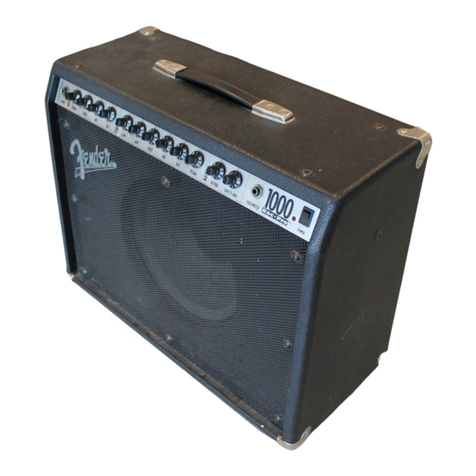Blackheart BH100H User manual

BH100H Hot Head
Guitar Amplifier Head
User’s Guide

2
TABLE OF CONTENTS
Introduction ..........................................................................3
BH100H Special Features......................................................4
The Front Panel ....................................................................5
The Rear Panel .....................................................................7
Important Information About Tubes and Tube Products ..........10
Settings To Get You Started.................................................13
System Block Diagram........................................................15
Technical Specifications.......................................................16
PORTABLE CART
WARNING
1. Read these instructions.
2. Keep these instructions.
3. Heed all warnings.
4. Follow all instructions.
5. Do not use this apparatus near water.
6. Clean only with a dry cloth.
7. Do not block any ventilation openings. Install in
accordance with the manufacturer’s instructions.
8. Do not install near any heat sources such as
radiators, heat registers, stoves, or other appara-
tus (including amplifiers) that produce heat.
9. Do not defeat the safety purpose of the polar-
ized or grounding-type plug. A polarized plug
has two blades with one wider than the other. A
grounding-type plug has two blades and a third
grounding prong. The wide blade or the third
prong are provided for your safety. If the provided
plug does not fit into your outlet, consult an elec-
trician for replacement of the obsolete outlet.
10.
Protect the power cord from being walked
on or pinched particularly at plugs, convenience
receptacles, and the point where they exit from
the apparatus.
11.
Only use attachments/accessories specified
by the manufacturer.
12.
Use only with a cart, stand,
tripod, bracket, or table specified
by the manufacturer, or sold with
the apparatus. When a cart is
used, use caution when moving
the cart/apparatus combination to
avoid injury from tip-over.
13.
Unplug this apparatus during lightning storms
or when unused for long periods of time.
IMPORTANT SAFETY INSTRUCTIONS
14.
Refer all servicing to qualified service person-
nel. Servicing is required when the apparatus has
been damaged in any way, such as power-supply
cord or plug is damaged, liquid has been spilled
or objects have fallen into the apparatus, the
apparatus has been exposed to rain or moisture,
does not operate normally, or has been dropped.
15.
Do not overload wall outlets and extension
cords as this can result in a risk of fire or electric
shock.
16.
This apparatus shall not be exposed to drip-
ping or splashing, and no object filled with liquids,
such as vases or beer glasses, shall be placed on
the apparatus.
17.
This apparatus has been designed with Class-I
construction and must be connected to a mains
socket outlet with a protective earthing connection
(the third grounding prong).
18.
This apparatus has been equipped with an all-
pole mains switch. This switch is located on the
front panel and should remain readily accessible
to the user.
CAUTION AVIS
RISK OF ELECTRIC SHOCK. DO NOT OPEN
RISQUE DE CHOC ELECTRIQUE. NE PAS OUVRIR
CAUTION: TO REDUCE THE RISK OF ELECTRIC SHOCK DO NOT REMOVE COVER (OR BACK)
NO USER-SERVICEABLE PARTS INSIDE. REFER SERVICING TO QUALIFIED PERSONNEL
ATTENTION: POUR EVITER LES RISQUES DE CHOC ELECTRIQUE, NE PAS ENLEVER LE COUVERCLE.
AUCUN ENTRETIEN DE PIECES INTERIEURES PAR L'USAGER.
CONFIER L'ENTRETIEN AU PERSONNEL QUALIFIE.
AVIS: POUR EVITER LES RISQUES D'INCENDIE OU D'ELECTROCUTION, N'EXPOSEZ PAS CET ARTICLE
A LA PLUIE OU A L'HUMIDITE
The lightning flash with arrowhead symbol within an equilateral triangle is
intended to alert the user to the presence of uninsulated "dangerous
voltage" within the product's enclosure, that may be of sufficient magnitude
to constitute a risk of electric shock to persons.
Le symbole éclair avec point de flèche à l'intérieur d'un triangle équilatéral
est utilisé pour alerter l'utilisateur de la présence à l'intérieur du coffret de
"voltage dangereux" non isolé d'ampleur suffisante pour constituer un risque
d'éléctrocution.
The exclamation point within an equilateral triangle is intended to alert the
user of the presence of important operating and maintenance (servicing)
instructions in the literature accompanying the appliance.
Le point d'exclamation à l'intérieur d'un triangle équilatéral est employé
pour alerter les utilisateurs de la présence d'instructions importantes pour le
fonctionnement et l'entretien (service) dans le livret d'instruction
accompagnant l'appareil.

3
Introduction
If power truly corrupts, then we welcome you to the club with open arms. That’s right, the Blackheart
BH100H packs everything but the kitchen sink into this thing of beauty. She is sexy as hell, but more
importantly, she sounds fantastic!
Under the hood is a clever little power block designed by none other than the Daddy of boutique amp
tone, Pyotr Belov. After you’re done staring at its unusually impressive build quality, showing it off to your
buddies and bandmates, and after you’ve stuck your complimentary Blackheart stickers on your guitar
case, plug it in and enjoy how a great tube amp sounds. Pluck out a few chimey riffs and then dig in
nice and hard so it breaks up and growls at you a bit. That’s a real amp you’re playing there friend. While
you’re at it, plug it into your favorite 4 x 12 cab and be prepared to lose your mind. Make sure to warn
the neighbors first!
And how about that build quality? Just like all Blackheart Engineering gear, the BH100H is a thing of
beauty inside and out. 16-gauge steel, 1.6 mm chassis with folded and spot-welded corners, double-
sided custom-colored PCB with big, thick, 2 oz. copper traces to keep your tone nice and fat all the way
through to the speaker….you name it, we’re doing it right. That’s because you took the time to find us,
to make us the official supplier of your personal quest for the best tone. There’s no way we’re lettin’ you
down. As always, you put your hard-earned cash on the table to get a piece of Blackheart gear and we
take that as a very personal thing. We’re in it for the long haul, just like you.
Vous avez notre coeur,
Blackheart Engineering
CONSIGNES DE SECURITE IMPORTANTES
- LIRE, SUIVRE TOUTES LES INSTRUCTIONS ET LES PRECAUTIONS D’UTILISATION
- NE PAS UTILISER PROCHE D’UNE SOURCE DE CHALEUR ET NE PAS BLOQUER OU OBSTRUER LE SYSTEME DE VENTILATION SUR CET
APPAREIL. POUR UNE UTILISATION CONFORME, CET APPAREIL NECESSITE ENVIRON 7CM D’ESPACE BIEN VENTILE AUTOUR DE SON
SYSTEME DE REFROIDISSEMENT, AINSI QU’UN COURANT D’AIR FRAIS CONSTANT
- NE PAS UTILISER CET APPAREIL PROCHE D’UNE SOURCE LIQUIDE
- NETTOYER SEULEMENT A L’AIDE D’UN CHIFFON DOUX ET SEC ET NE PAS UTILISER DE PRODUITS MENAGERS
- CONNECTER UNIQUEMENT LE CABLE D’ALIMENTATION FOURNI SUR UNE PRISE AVEC MISE A LA TERRE, ET COMPATIBLE AVEC LA
TENSION, L’INTENSITE ET LA FREQUENCE REQUISES INDIQUEES SUR LA FACE ARRIERE DE L’APPAREIL
- S’ASSURER DE NE PAS MARCHER, PLIER OU TIRER SUR LE CABLE D’ALIMENTATION
- DEBRANCHER L’APPAREIL LORS D’UNE TEMPETE OU LORS D’UNE TRES LONGUE PERIODE DE NON UTILISATION
- UTILISER UNIQUEMENT DES ACCESSOIRES SPECIFIES PAR LE FABRICANT POUR UNE UTILISATION EN TOUTE SECURITE ET POUR EVITER
DES BLESSURES
- ATTENTION: AFIN DE PREVENIR TOUT RISQUE DE CHOCS ELECTRIQUES OU DE DEBUT D’INCENDIE, NE PAS EXPOSER CET APPAREIL A
LA PLUIE ET A L’HUMIDITE
- TOUT ENTRETIEN DOIT ETRE FAIT PAR UN TECHNICIEN QUALIFIE
- NOS AMPLIFICATEURS PEUVENT PRODUIRE DE TRES HAUTES PRESSIONS ACOUSTIQUES QUI PEUVENT CAUSER DES DOMMAGES
AUDITIFS PERMANENTS OU DEFINITIFS. L’UTILISER AVEC UNE GRANDE PRECAUTION EST CONSEILLE ET DES PROTECTIONS AUDITIVES
SONT RECOMMANDEES POUR UNE UTILISATION A FORT VOLUME.
- ATTENTION: CET APPAREIL REQUIERT UNE PRISE MURALE AVEC MISE A LA TERRE, AUX NORMES ACTUELLES ET COMPATIBLE AVEC LES
SPECIFICATIONS ELECTRIQUES SE TROUVANT EN FACE ARRIERE DE L’APPAREIL. LA PRISE ELECTRIQUE DOIT RESTER ACCESSIBLE POUR
DEBRANCHER L’APPAREIL EN CAS DE DEFAUT PENDANT L’UTILISATION
- CET APPAREIL DOIT ETRE DEBRANCHE SI IL N’EST PAS UTILISE
Elimination correcte du produit : Ce symbole indique que ce produit ne doit pas être éliminé avec les ordures ménagères, comme le prévoiT
la directive WEEE (2002/96/EC) et votre loi nationale.
Ce produit doit être remis à un site de recyclage des déchets électriques et des équipements électroniques (EEE).
Un mauvais recyclage de ce type de déchet peut avoir de possibles impacts négatifs sur l’environnement et la santé humaine dus aux émana-
tions de substances.
Dans un même temps, votre coopération à un recyclage correct de ce produit contribuera à la bonne utilisation des ressources naturelles.
Pour connaître l’endroit où il est possible de recycler ces équipements, merci de contacter votre mairie, les services de recyclages ou le
service des déchets ménagers.

4
BH100H Special Features:
• Versatile, yet simple to operate, 100W head with selectable power and class of operation.
• 100 Watts RMS in Pentode mode, 50 Watts in Triode mode via Class-AB, push-pull
operation.
• 60 Watts RMS in Pentode mode, 30 Watts in Triode mode via Class-A, push-pull
operation.
• All tube signal path
• Six 12AX7/ECC83 preamp tubes
• Four EL34/6CA7 power amp tubes
• Two independent channels
• Channel 1 (LOUD) with Drive, Level, Treble, Middle, and Bass controls. This channel
is voiced for crisp cleans, classic rock and heavy blues tones.
• Channel 2 (F’N LOUD) with Gain, Level, Treble, Middle, and Bass controls. This
channel is voiced to capture classic crunch and sweet overdriven lead tones.
• Both channels share the Master Volume and Presence controls.
• 4, 8, and 16 ohm speaker outputs and 1/4” line output.
• Global presence and master volume control over both channels.
• Tube-buffered effects loop (shared by both channels) may operate in Series or Parallel
modes with Send Level and Return Level controls.
• Two-button footswitch:
• Channel selection.
• Effects loop on/off or boost on/off.
• Solid State rectifier.
• DC-powered filaments (in the preamp tubes) for quiet operation.
• Extra rugged construction:
• Chassis: 16-gauge, 1.6 mm chassis with folded and spot-welded corners.
• Cabinet: 13-ply (18 mm thick) void-free plywood construction.
• PCB: Double-sided custom color printed circuit board with 2 oz. copper traces.
• Over-Spec’d components.

5
The Front Panel: Power & Master Section
1. ON/OFF SWITCH: Use this switch to
turn the amplifier on and off.
2. CLASS AB/STAND BY/CLASS A:
Before turning on the amplifier, be sure
to set the switch to ‘Stand by’ (middle
position). After a minute or two, the
amplifier will have warmed up and you
may choose between Class AB or Class
A operation. Class AB is fixed-biased
and delivers 100 watts at full-power
or 50 watts at half-power. Class A is
cathode-biased and delivers 60 watts at
full-power or 30 watts at half-power.
3. FULL/HALF POWER: This is the
Pentode/Triode switch. It allows you
to operate the amplifier in two distinct
STAND
BY
ON
OFF
FULL POWER
HALF POWER
CLASS AB
CLASS A
H
O
T
H
E
A
D
100 0 10 0 10 0 10 0 10 0 10
0 10
0 10 0 10 0 10 0 10 0 10
INPUT
BASS MIDDLE
MIDDLE TREBLE LEVEL DRIVE
BASSPRESENCE VOLUME TREBLE LEVEL GAIN CHANNEL
SELECT
0 10
BH100H MASTER CHANNEL TWO – F’N LOUD CHANNEL ONE – LOUD
1 2 3 4 5 6 7 8 9 10 1211 1813 14 15 16 17 19 20
modes of operation and output power
rating. The Pentode is the aggressive
setting that gives you full output power,
while the Triode is a smoother setting
that reduces the output power by 50%.
4. INDICATOR LAMP: This illuminates
when the amplifier is turned on (pow-
ered up, that is).
5. MASTER PRESENCE: Use this to
adjust the high frequency of the output
section. The adjustment range is 5 dB
at 20 kHz.
6. MASTER VOLUME: Use this to adjust
the overall output level.

6
7. BASS: Use this to adjust the output
level of the low frequencies. The adjust-
ment range is 8 dB at 100 Hz.
8. MIDDLE: Use this to adjust the output
level of the mid frequencies. The adjust-
ment range is 8 dB at 1 kHz.
9. TREBLE: Use this to adjust the output
level of the high frequencies. The adjust-
ment range is 11 dB at 10 kHz.
10. LEVEL: Use this to adjust the output
level of Channel Two. It is located
STAND
BY
ON
OFF
FULL POWER
HALF POWER
CLASS AB
CLASS A
H
O
T
H
E
A
D
100 0 10 0 10 0 10 0 10 0 10
0 10
0 10 0 10 0 10 0 10 0 10
INPUT
BASS MIDDLE
MIDDLE TREBLE LEVEL DRIVE
BASSPRESENCE VOLUME TREBLE LEVEL GAIN CHANNEL
SELECT
0 10
BH100H MASTER CHANNEL TWO – F’N LOUD CHANNEL ONE – LOUD
1 2 3 4 5 6 7 8 9 10 1211 1813 14 15 16 17 19 20
between the output of the EQ and
before the input to the effects loop.
11. CHANNEL TWO INDICATOR LED:
This LED lights up when Channel Two is
selected.
12. GAIN: Use this to adjust the preamp
gain level.
13. CHANNEL SELECT: Use this switch
to select between Channel One and
Channel Two. The Channel Select
Switch is bypassed if the footswitch is
plugged in.
STAND
BY
ON
OFF
FULL POWER
HALF POWER
CLASS AB
CLASS A
H
O
T
H
E
A
D
100 0 10 0 10 0 10 0 10 0 10
0 10
0 10 0 10 0 10 0 10 0 10
INPUT
BASS MIDDLE
MIDDLE TREBLE LEVEL DRIVE
BASSPRESENCE VOLUME TREBLE LEVEL GAIN CHANNEL
SELECT
0 10
BH100H MASTER CHANNEL TWO – F’N LOUD CHANNEL ONE – LOUD
1 2 3 4 5 6 7 8 9 10 1211 1813 14 15 16 17 19 20
14. BASS: Use this to adjust the output
level of the low frequencies. The adjust-
ment range is 8 dB at 100 Hz.
15. MIDDLE: Use this to adjust the output
level of the mid frequencies. The adjust-
ment range is 9 dB at 1 kHz.
16. TREBLE: Use this to adjust the output
level of the high frequencies. The adjust-
ment range is 11 dB at 10 kHz.
17. LEVEL: Use this to adjust the output
level of Channel One. It is located
between the output of the EQ and
before the input to the effects loop.
18. CHANNEL ONE INDICATOR LED:
This LED lights up when Channel One is
selected.
19. DRIVE: Use this to adjust the preamp
drive level.
20. INPUT: Use this jack to connect your
guitar to the amplifier using a high-qual-
ity shielded instrument cable.
The Front
Panel:
Channel Two
F’n Loud
Section
The Front
Panel:
Channel One
Loud
Section

7
The Rear Panel:
The rear panel has connections for the AC
power cord, external speaker cabinets, a
line out, an effects loop and a footswitch.
WARNING! Never turn on or use the ampli-
fier without a load or speaker connected to
the amplifier.
21. AC Power Input with Mains Fuse:
Your amplifier is equipped with a
detachable power cable that plugs into
the IEC Mains socket on the back of the
amplifier. The AC power cord should
only be plugged into a grounded power
outlet that meets all applicable electri-
cal codes and is compatible with the
voltage, power, and frequency require-
ments stated on the rear panel of the
amplifier. Do not attempt to defeat the
safety ground connection. The AC Mains
fuse is located in the IEC Mains socket
and is used to protect the amplifier
from electrical faults. If the fuse needs
to be replaced, please refer to the
correct fuse specifications located on
the back panel of the amplifier. Always
unplug the power cord when changing
or inspecting the fuse. Never bypass
the fuse or replace it with a wrong type
or value.
22. RETURN LEVEL: When in Series
mode, this control is used as a level
of returning wet/dry signal. In Series
mode, the wet/dry signal is mixed thru
your effects. When used in Parallel
mode, this control allows the player to
increase the level of the effects.
23. EFFECT RETURN: This jack is desig-
nated to be connected (using a good
quality shielded cable) to the output of
your last external effect (if more than
one effect is used).
24. EFFECT SEND: This jack is designated
to be connected (using a good quality
shielded cable) to the input of your first
external effect.
25. SEND LEVEL: Use this to control the
guitar’s signal level that is being sent
into your first effect. This allows you to
use external rack effects and foot ped-
als through the effects loop.
26. SERIES/PARALLEL: This switch allows
you to select between Series or Parallel
mode of operation.
27. FOOT SWITCH: If the foot switch is not
plugged into the amplifier, the FX loop
is ON and the loop’s Send and Return
level controls are active. If you are not
using the footswitch as a level boost
and/or you are not using the effect loop
for your effects, be sure the Series/
Parallel switch is set to Series and the
Send and Return level controls are set
so you do not lose any signal.
Using the Effects Loop as a Level Boost
If effects are not needed, the Effects
Loop may be utilized as a Level Boost for
your awesome lead. Keep in mind that the
Effects Loop is, in fact, a (limited) gain
stage. Therefore, the Effects Loop may be
engaged in order to meet that extra needed
gain or level boost.
4 OHMS
LINE OUT
FOOT
SWITCH
EFFECT
SEND
SEND LEVEL EFFECT
RETURN
4 OHMS 8 OHMS 8 OHMS 16 OHMS 0 10
RETURN LEVEL
0 10
SERIES
PARALLEL
212223242830 2931 252627

8
The Rear Panel con’t...
4 OHMS
LINE OUT
FOOT
SWITCH
EFFECT
SEND
SEND LEVEL EFFECT
RETURN
4 OHMS 8 OHMS 8 OHMS 16 OHMS 0 10
RETURN LEVEL
0 10
SERIES
PARALLEL
212223242830 2931 252627
Here is how it works: set the Series/Parallel
switch to Series mode. Next, set the Send
and Return level controls to their maximum
settings and set FX/Boost to ON (the red
LED on the footswitch will illuminate). This
is the maximum boosted signal level. When
you turn the FX/Boost OFF, the Send and
Return level controls are bypassed. You
should notice a difference in the output
level when switching the FX/Boost ON and
OFF. Now that you found the range of your
boost (approximately 3dB), you will want to
find the unity level. Lower the Return level
control (in the ON position) until it matches
the bypass signal level. You will find that the
unity is at about the 50% mark. Now that
you have established the Unity and the Max
Boost settings it is time to find the sweet
spot for your awesome lead. Feel free to
experiment with these levels until
your
sound
is captured.
28. 16 OHMS: The 16 ohm speaker output
jack is designated for 16 ohm speaker
cabinets only, such as the Blackheart
BH110, BH112, BH412SL or BH412ST.
29. 8 OHMS: The 8 ohm speaker output
jack is designated for use with one 8
ohm speaker cabinet, or two 16 ohm
cabinets that are connected parallel.
30. 4 OHMS: The 4 ohms speaker output
jack is designated for use with one 4
ohm speaker cabinet, or two 8 ohm
cabinets that are connected parallel.
31. LINE OUT: The line output jack is des-
ignated to go directly to the board or
speaker simulator for recording. Even
if utilizing the line out feature, a load or
speaker still needs to be connected to
the amplifier.
Connecting speaker cabinets
The hookup diagrams on the next page
show some different cabinets, their imped-
ance, where to plug them in, and the total
load impedance placed on the amplifier.
ALWAYS use good quality (non-shielded)
speaker cable to connect speaker cabinets.
Never use (shielded) instrument cable.
ALWAYS match the amplifier’s speaker
output impedance to the impedance of the
speaker that is being used.
• If more than one speaker is connected
together in parallel, make sure they all
have the same impedance rating.
• When using multiple speaker cabinets
(with the same impedance rating),
match the total load impedance of the
speaker cabinets to the speaker output
of the amplifier.
For equal-impedance speakers connected in
parallel, the first law of rock and roll states:
SPEAKER CABINET IMPEDANCE divided by
NUMBER OF CABINETS = TOTAL LOAD

9
Typical connections to speaker cabinets
4 OHMS 4 OHMS 8 OHMS 8 OHMS 16 OHMS
4 OHMS 4 OHMS 8 OHMS 8 OHMS 16 OHMS
4 OHMS 4 OHMS 8 OHMS 8 OHMS 16 OHMS
4 OHMS 4 OHMS 8 OHMS 8 OHMS 16 OHMS
4 OHMS 4 OHMS 8 OHMS 8 OHMS 16 OHMS
4 OHMS 4 OHMS 8 OHMS 8 OHMS 16 OHMS
4 OHMS 4 OHMS 8 OHMS 8 OHMS 16 OHMS
4 OHMS 4 OHMS 8 OHMS 8 OHMS 16 OHMS
16Ω16Ω
8Ω16Ω16Ω
8Ω8Ω
8Ω8Ω
Two 16 ohm cabinets. Total Load = 8 ohm
Use one 8 ohm output jack.
One 8 ohm cabinet. Total Load = 8 ohm
Use an 8 ohm output jack.
Four 16 ohm cabinets in parallel.
Total Load = 4 ohm. Use a 4 ohm output jack.
(This is a possible system, but unlikely. It was
thrown in while we were on a theoretical roll)
Two 16 ohm cabinets. Total Load = 8 ohm
Use both 8 ohm output jacks.
Two 8 ohm cabinets. Total Load = 4 ohm
Use one 4 ohm output jack.
Two 8 ohm cabinets. Total Load = 4 ohm
Use both 4 ohm output jacks.
Speaker
Cabinets
in parallel
Speaker
Cabinets
One 16 ohm cabinet. Total Load = 16 ohm
Use the 16 ohm output jack.
16Ω
Speaker
Cabinet
4Ω
One 4 ohm cabinet. Total Load = 4 ohm
Use a 4 ohm output jack.
Speaker
Cabinets
in parallel
Speaker
Cabinets
Speaker
Cabinet
Speaker
Cabinet
16Ω16Ω16Ω16Ω

10
The Nature Of Tubes — Why (And When) To Replace Them:
Tubes are made up of a number of fragile mechanical components that are vacuum-sealed in a
glass envelope or bubble. The tube’s longevity is based on a number of factors which include
how hard and often the amplifier is played, vibration from the speakers, road travel, repeated
set up and tear down, etc.
Any time you notice a change in your amplifier’s performance, check the tubes first.
If it’s been a while since the tubes were replaced and the sound from your amplifier lacks
punch, fades in and out, loses highs or lows or produces unusual sounds, the power tubes
probably need to be replaced. If your amplifier squeals, makes noise, loses gain, starts to
hum, lacks “sensitivity”, or feels as if it is working against you, the preamplifier tubes may
need to be replaced.
The power tubes are subjected to considerably more stress than the preamplifier tubes.
Consequently, they almost always fail/degrade first. If deteriorating power tubes aren’t
replaced they will ultimately fail. Depending on the failure mode, they may even cause severe
damage to the audio output transformer and/or other components in the amplifier. Replacing
the tubes before they fail completely has the potential to save you time, money and unwanted
trouble. Since power tubes work together in an amplifier, it is crucial that they (if there is more
than one) be replaced by a matched set. If you’re on the road a lot, we recommend that you
carry a spare matched set of replacement power tubes and their associated driver tubes.
After turning off the power and disconnecting the amplifier from the power source, carefully
check the tubes (in bright light) for cracks or white spots inside the glass or any other appar-
ent damage. Then, with the power on, view the tubes in a dark room. Look for preamplifier
tubes that do not glow at all or power tubes that glow excessively red.
Whenever you replace the power tube(s):
• Always have the amplifier’s bias voltage checked by a qualified service center. Improper
bias voltage will cause degradation in performance and possibly damage the tubes and/or
the amplifier. (See “The Importance of Proper Biasing”, below for more information).
• We highly recommend that you replace the driver tube(s) as well. The driver tube deter-
mines the shape and amplitude of the signal applied to the power tube(s) and has to work
almost as hard as the power tube(s).
You can check your preamplifier tubes for microphonics by turning the amplifier on, turning up
the gain and tapping lightly on each tube with the end of a pencil or a chop stick (my favorite).
You will be able to hear the tapping through your speakers, which is normal. It is not normal
for a tube to ring like a bell after it’s tapped. If it does ring then it’s microphonic and should be
replaced. Remember to use only high quality, low microphonic tubes in the preamplifier section.
Even though power tubes are rarely microphonic, you should check them anyway. The power
tubes can be checked for microphonics just like pre-amp tubes.
In the case of very high gain amps, you may be able to reduce the amount of noise generated
by simply swapping the preamp tubes around.
Important Information about Tubes and Tube Products:

11
The Importance Of Proper Biasing:
For the best performance and longest tube life, proper biasing is imperative. Bias is the nega-
tive voltage which is applied to the power tube’s control grid to set the level of idle current.
We cannot over emphasize the difference in warmth of tone and dynamic response that come
with proper biasing. If the bias is set too high (over biased), the sound from the amp will be
distorted at all levels. If the bias is set too low, (under biased) the power tubes will run hot (the
plates inside the tubes may glow red due to excessive heat) and the sound from the amplifier
will lack power and punch. The excessive heat greatly reduces tube life – from a few days to
as little as a few hours in extreme cases. Setting the bias on your amp is like setting the idle
on your car. If it’s too high or hot it’s running away with you and if it’s too low or cold it will
choke when you step on it.
The bias is adjusted at the factory in accordance with the type of power tube(s) installed in
your amplifier. It is important to point out that tubes of the same type and specification typi-
cally exhibit different performance characteristics. Consequently, whenever power tubes are
replaced, the bias voltage must be checked (unless the amplifier is equipped with “self-biasing”
circuitry) and readjusted to accommodate the operating parameters of the replacement tubes.
Depending on the model and amplifier type, there may be hum balance controls, trim pots, or
bias adjustment controls on its rear panel. However, the bias adjustment should be performed
only by qualified service personnel with the proper, calibrated test equipment.
Important Information About Tubes and Tube Products (continued):

12
Survival Tips For Tube Amplifiers:
To prolong tube life, observe these tips and recommendations:
• Match the impedance of your speaker cabinet(s) to your amplifier. Improper impedance
matching will contribute to early tube degradation and may cause premature tube failure.
• Make sure the speaker(s) are properly connected prior to turning on the amplifier.
• After playing the amplifier, allow sufficient time for it to properly cool down prior to moving
it. A properly cooled amplifier prolongs tube life due to the internal components being less
susceptible to the damage caused by vibration.
• Allow the amplifier to warm up to room temperature before turning it on. The heat gener-
ated by the tube elements can crack a cold glass housing.
• Replace the output tube(s) before the performance degrades or the tubes fail completely.
Replace the tube(s) on a regular basis (at least once per year or as often as every 4 to 6
months if you play long and hard every day).
• Always have the bias checked after replacing the output tubes (unless the amplifier is
equipped with “self-biasing circuitry”). This should be done ONLY at a qualified service
center. Improper biasing could result in the tubes running too hot, which greatly reduces
the life of the tubes – or too cold, which results in distorted sound regardless of level
settings. Do not play the amplifier if it exhibits these symptoms – get the bias checked/
adjusted immediately to prevent tube failure and/or other damage.
• If the locating notch on the base of a power tube breaks off, replace the tube. This signifi-
cantly reduces the risk of damaging your amplifier by incorrectly inserting the tube.
• Protect the amplifier from dust and moisture. If liquid gets into the amplifier proper, or
if the amplifier is dropped or otherwise mechanically abused, have it checked out at an
authorized service center before using it.
• Proper maintenance and cleaning in combination with routine checkups by your authorized
service center will insure the best performance and longest life from your amplifier.
CAUTION: Tube replacement should be performed only by qualified service personnel
who are familiar with the dangers of hazardous voltages that are typically present in
tube circuitry.
Important Information About Tubes and Tube Products (continued):

13
Some Favorite in-house BH100H Settings (Channel 1 - LOUD):
Setting One: Moving Air
Setting Four: Shade of Blue
Setting Two: Jazz Mach II
Setting Three: Kleen
Setting Five: Just Pure Uninterrupted Rock
ON
OFF
FULL POWER
HALF POWER
CLASS AB
CLASS A
H
O
T
H
E
A
D
100 0 10 0 10 0 10 0 10 0 10
0 10
0 10 0 10 0 10 0 10 0 10
INPUT
STAND
BY
BASS MIDDLE
MIDDLE TREBLE LEVEL DRIVE
BASSPRESENCE VOLUME TREBLE LEVEL GAIN CHANNEL
SELECT
0 10
BH100H MASTER CHANNEL TWO – F’N LOUD CHANNEL ONE – LOUD
ON
OFF
FULL POWER
HALF POWER
CLASS AB
CLASS A
H
O
T
H
E
A
D
100 0 10 0 10 0 10 0 10 0 10
0 10
0 10 0 10 0 10 0 10 0 10
INPUT
STAND
BY
BASS MIDDLE
MIDDLE TREBLE LEVEL DRIVE
BASSPRESENCE VOLUME TREBLE LEVEL GAIN CHANNEL
SELECT
0 10
BH100H MASTER CHANNEL TWO – F’N LOUD CHANNEL ONE – LOUD
ON
OFF
FULL POWER
HALF POWER
CLASS AB
CLASS A
H
O
T
H
E
A
D
100 0 10 0 10 0 10 0 10 0 10
0 10
0 10 0 10 0 10 0 10 0 10
INPUT
STAND
BY
BASS MIDDLE
MIDDLE TREBLE LEVEL DRIVE
BASSPRESENCE VOLUME TREBLE LEVEL GAIN CHANNEL
SELECT
0 10
BH100H MASTER CHANNEL TWO – F’N LOUD CHANNEL ONE – LOUD
ON
OFF
FULL POWER
HALF POWER
CLASS AB
CLASS A
H
O
T
H
E
A
D
100 0 10 0 10 0 10 0 10 0 10
0 10
0 10 0 10 0 10 0 10 0 10
INPUT
STAND
BY
BASS MIDDLE
MIDDLE TREBLE LEVEL DRIVE
BASSPRESENCE VOLUME TREBLE LEVEL GAIN CHANNEL
SELECT
0 10
BH100H MASTER CHANNEL TWO – F’N LOUD CHANNEL ONE – LOUD
ON
OFF
FULL POWER
HALF POWER
CLASS AB
CLASS A
H
O
T
H
E
A
D
100 0 10 0 10 0 10 0 10 0 10
0 10
0 10 0 10 0 10 0 10 0 10
INPUT
STAND
BY
BASS MIDDLE
MIDDLE TREBLE LEVEL DRIVE
BASSPRESENCE VOLUME TREBLE LEVEL GAIN CHANNEL
SELECT
0 10
BH100H MASTER CHANNEL TWO – F’N LOUD CHANNEL ONE – LOUD
ON
OFF
FULL POWER
HALF POWER
CLASS AB
CLASS A
H
O
T
H
E
A
D
100 0 10 0 10 0 10 0 10 0 10
0 10
0 10 0 10 0 10 0 10 0 10
INPUT
STAND
BY
BASS MIDDLE
MIDDLE TREBLE LEVEL DRIVE
BASSPRESENCE VOLUME TREBLE LEVEL GAIN CHANNEL
SELECT
0 10
BH100H MASTER CHANNEL TWO – F’N LOUD CHANNEL ONE – LOUD
ON
OFF
FULL POWER
HALF POWER
CLASS AB
CLASS A
H
O
T
H
E
A
D
100 0 10 0 10 0 10 0 10 0 10
0 10
0 10 0 10 0 10 0 10 0 10
INPUT
STAND
BY
BASS MIDDLE
MIDDLE TREBLE LEVEL DRIVE
BASSPRESENCE VOLUME TREBLE LEVEL GAIN CHANNEL
SELECT
0 10
BH100H MASTER CHANNEL TWO – F’N LOUD CHANNEL ONE – LOUD
ON
OFF
FULL POWER
HALF POWER
CLASS AB
CLASS A
H
O
T
H
E
A
D
100 0 10 0 10 0 10 0 10 0 10
0 10
0 10 0 10 0 10 0 10 0 10
INPUT
STAND
BY
BASS MIDDLE
MIDDLE TREBLE LEVEL DRIVE
BASSPRESENCE VOLUME TREBLE LEVEL GAIN CHANNEL
SELECT
0 10
BH100H MASTER CHANNEL TWO – F’N LOUD CHANNEL ONE – LOUD
ON
OFF
FULL POWER
HALF POWER
CLASS AB
CLASS A
H
O
T
H
E
A
D
100 0 10 0 10 0 10 0 10 0 10
0 10
0 10 0 10 0 10 0 10 0 10
INPUT
STAND
BY
BASS MIDDLE
MIDDLE TREBLE LEVEL DRIVE
BASSPRESENCE VOLUME TREBLE LEVEL GAIN CHANNEL
SELECT
0 10
BH100H MASTER CHANNEL TWO – F’N LOUD CHANNEL ONE – LOUD
ON
OFF
FULL POWER
HALF POWER
CLASS AB
CLASS A
H
O
T
H
E
A
D
100 0 10 0 10 0 10 0 10 0 10
0 10
0 10 0 10 0 10 0 10 0 10
INPUT
STAND
BY
BASS MIDDLE
MIDDLE TREBLE LEVEL DRIVE
BASSPRESENCE VOLUME TREBLE LEVEL GAIN CHANNEL
SELECT
0 10
BH100H MASTER CHANNEL TWO – F’N LOUD CHANNEL ONE – LOUD

14
Some Favorite in-house BH100H Settings (Channel 2 - F’N LOUD):
Setting Ten: Rock On!
Setting Seven: Chuka, Chuka Grunge
Setting Eight: Smooth Lead
Setting Six: Whole Lotta Attitude
Setting Nine: Grit
ON
OFF
FULL POWER
HALF POWER
CLASS AB
CLASS A
H
O
T
H
E
A
D
100 0 10 0 10 0 10 0 10 0 10
0 10
0 10 0 10 0 10 0 10 0 10
INPUT
STAND
BY
BASS MIDDLE
MIDDLE TREBLE LEVEL DRIVE
BASSPRESENCE VOLUME TREBLE LEVEL GAIN CHANNEL
SELECT
0 10
BH100H MASTER CHANNEL TWO – F’N LOUD CHANNEL ONE – LOUD
ON
OFF
FULL POWER
HALF POWER
CLASS AB
CLASS A
H
O
T
H
E
A
D
100 0 10 0 10 0 10 0 10 0 10
0 10
0 10 0 10 0 10 0 10 0 10
INPUT
STAND
BY
BASS MIDDLE
MIDDLE TREBLE LEVEL DRIVE
BASSPRESENCE VOLUME TREBLE LEVEL GAIN CHANNEL
SELECT
0 10
BH100H MASTER CHANNEL TWO – F’N LOUD CHANNEL ONE – LOUD
ON
OFF
FULL POWER
HALF POWER
CLASS AB
CLASS A
H
O
T
H
E
A
D
100 0 10 0 10 0 10 0 10 0 10
0 10
0 10 0 10 0 10 0 10 0 10
INPUT
STAND
BY
BASS MIDDLE
MIDDLE TREBLE LEVEL DRIVE
BASSPRESENCE VOLUME TREBLE LEVEL GAIN CHANNEL
SELECT
0 10
BH100H MASTER CHANNEL TWO – F’N LOUD CHANNEL ONE – LOUD
ON
OFF
FULL POWER
HALF POWER
CLASS AB
CLASS A
H
O
T
H
E
A
D
100 0 10 0 10 0 10 0 10 0 10
0 10
0 10 0 10 0 10 0 10 0 10
INPUT
STAND
BY
BASS MIDDLE
MIDDLE TREBLE LEVEL DRIVE
BASSPRESENCE VOLUME TREBLE LEVEL GAIN CHANNEL
SELECT
0 10
BH100H MASTER CHANNEL TWO – F’N LOUD CHANNEL ONE – LOUD
ON
OFF
FULL POWER
HALF POWER
CLASS AB
CLASS A
H
O
T
H
E
A
D
100 0 10 0 10 0 10 0 10 0 10
0 10
0 10 0 10 0 10 0 10 0 10
INPUT
STAND
BY
BASS MIDDLE
MIDDLE TREBLE LEVEL DRIVE
BASSPRESENCE VOLUME TREBLE LEVEL GAIN CHANNEL
SELECT
0 10
BH100H MASTER CHANNEL TWO – F’N LOUD CHANNEL ONE – LOUD

15
System Block Diagram
NOTE: This equipment has been tested and found
to comply with the limits for a Class B digital
device, pursuant to part 15 of the FCC Rules.
These limits are designed to provide reason-
able protection against harmful interference in a
residential installation. This equipment generates,
uses, and can radiate radio frequency energy
and, if not installed and used in accordance with
the instructions, may cause harmful interference
to radio communications. However, there is no
guarantee that interference will not occur in a
particular installation. If this equipment does
cause harmful interference to radio or television
reception, which can be determined by turning the
equipment off and on, the user is encouraged to
try to correct the interference by one or more of
the following measures:
• Reorient or relocate the receiving antenna.
• Increase the separation between the equip-
ment and the receiver.
• Connect the equipment into an outlet on a cir-
cuit different from that to which the receiver
is connected.
• Consult the dealer or an experienced radio/
TV technician for help.
CAUTION: Changes or modifications to this
device not expressly approved by LOUD
Technologies Inc. could void the user's authority
to operate the equipment under FCC rules.
This apparatus does not exceed the Class
A/Class B (whichever is applicable)
limits for
radio noise emissions from digital apparatus as
set out in the radio interference regulations of the
Canadian Department
of Communications.
Duration,
per day in
hours
Sound Level
dBA, Slow
Response
Typical Example
8 90 Duo in small club
6 92
4 95 Subway Train
3 97
2 100 Very loud classical music
1.5 102
1 105 Pyotr screaming at Zane and Troy
about deadlines
0.5 110
0.25 or less 115 Loudest parts at a rock concert
ATTENTION — Le présent appareil numérique
n’émet pas de bruits radioélectriques dépassant
las limites applicables aux appareils numériques
de class A/de class B (selon le cas) prescrites
dans le réglement sur le brouillage radioélectrique
édicté par les ministere des communications du
Canada.
Exposure to extremely high noise levels may
cause permanent hearing loss. Individuals vary
considerably in susceptibility to noise-induced
hearing loss, but nearly everyone will lose some
hearing if exposed to sufficiently intense noise
for a period of time. The U.S. Government’s
Occupational Safety and Health Administration
(OSHA) has specified the permissible noise level
exposures shown in the following chart.
According to OSHA, any exposure in excess
of these permissible limits could result in some
hearing loss. To ensure against potentially danger-
ous exposure to high sound pressure levels, it is
recommended that all persons exposed to equip-
ment capable of producing high sound pressure
levels use hearing protectors while the equipment
is in operation. Ear plugs or protectors in the ear
canals or over the ears must be worn when oper-
ating the equipment in order to prevent permanent
hearing loss if exposure is in excess of the limits
set forth here:

16
BH100H TECHNICAL SPECIFICATIONS
Output Power Rating @ 5% THD Class AB: Full Power - 100W, Half Power - 50W
Class A: Full Power - 60W, Half Power - 30W
Input Impedance 1 Meg Ohm
Preamp Tubes 6 of 12AX7/ECC83
Power Tubes 4 of EL34/6CA7
Rectifier Solid State
Speaker Outputs 1 x 16 ohms, 2 x 8 ohms, 2 x 4 ohms
Power Requirements 110/120 VAC, 50/60 Hz, 400 W
220/240 VAC, 50/60 Hz, 400 W
AC Mains Fuse 100/120 VAC: T6.3 AL 250V Fuse
220/240 VAC: T3.15 AL 250V Fuse
Size Height - 11.625 in/295 mm (including feet),
Depth - 11 in/280 mm, Width - 30 in/760 mm
Weight 52.0 lb/23.6 kg
The Blackheart BH100H Hot Head is covered with a durable fabric-backed vinyl material. Wipe it
clean with a lint-free cloth. Never spray cleaning agents onto the cabinet. Avoid abrasive cleansers
which would damage the finish.
Blackheart continually develops new products, as well as improves existing ones. For this reason, the specifica-
tions and information in this manual are subject to change without notice.
“Blackheart” is a registered trademark of LOUD Technologies Inc. All other brand names mentioned are trade-
marks or registered trademarks of their respective holders and are hereby acknowledged.
Service Information
If you are having a problem with your Blackheart BH100H Hot Head, you can go to our website
(www.blackhearteng.com) and click on “Heart Surgery” for service information, or call 1-800-
898-3211 Monday-Friday, during normal business hours, Pacific Time, to explain the problem. If
you are outside of the U.S., contact your local distributor for technical support and service.
Correct disposal of this product: This symbol indicates that this product should not be disposed of with your household waste,
according to the WEEE directive (2002/96/EC) and your national law. This product should be handed over to an authorized collec-
tion site for recycling waste electrical and electronic equipment (EEE). Improper handling of this type of waste could have a possible
negative impact on the environment and human health due to potentially hazardous substances that are generally associated with
EEE. At the same time, your cooperation in the correct disposal of this product will contribute to the effective usage of natural
resources. For more information about where you can drop off your waste equipment for recycling, please contact your local city
office, waste authority, or your household waste disposal service.
BLACKHEART ENGINEERING
AMPLIFIER SERIES
www.blackhearteng.com
@2009 LOUD Technologies Inc.
16220 Wood-Red Road NE • Woodinville, WA 98072
Part No. SW0740 Rev. A 03/09
This manual suits for next models
1
Table of contents
Other Blackheart Musical Instrument Amplifier manuals
Popular Musical Instrument Amplifier manuals by other brands
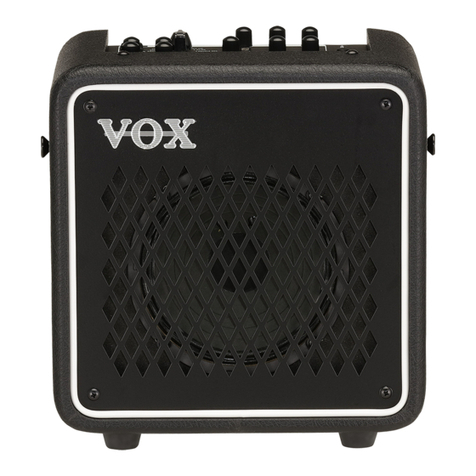
VOX Amplification
VOX Amplification MINI GO 3 owner's manual
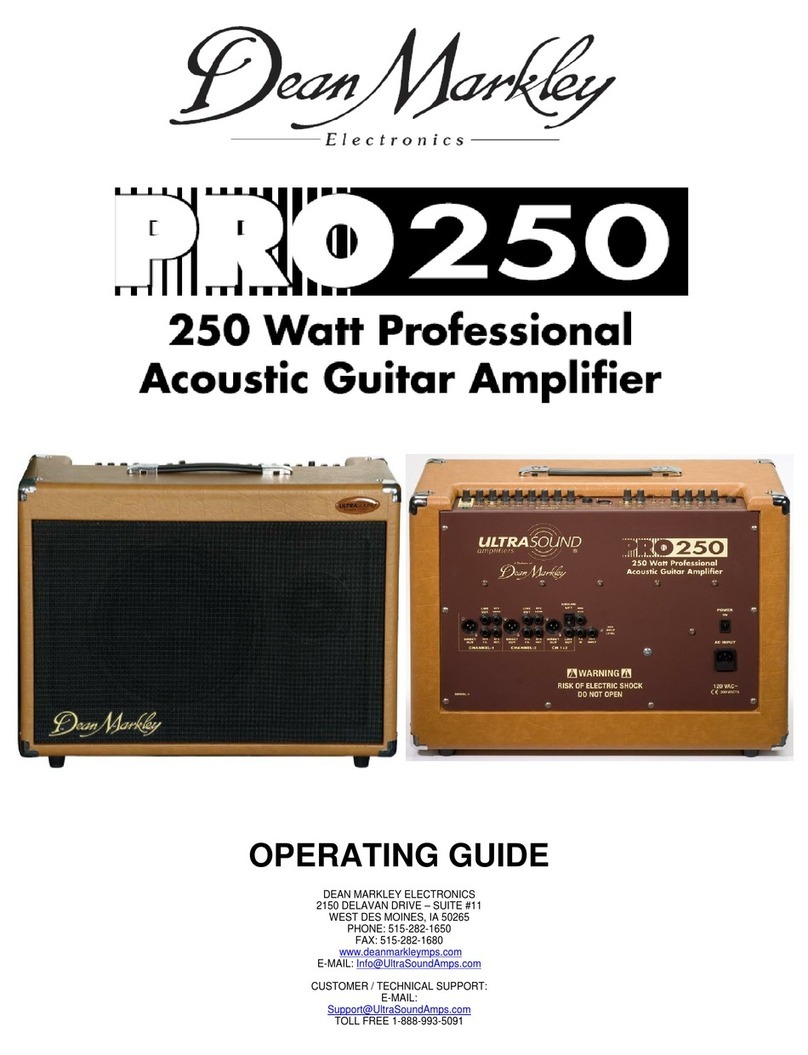
Dean
Dean PRO250 operating guide
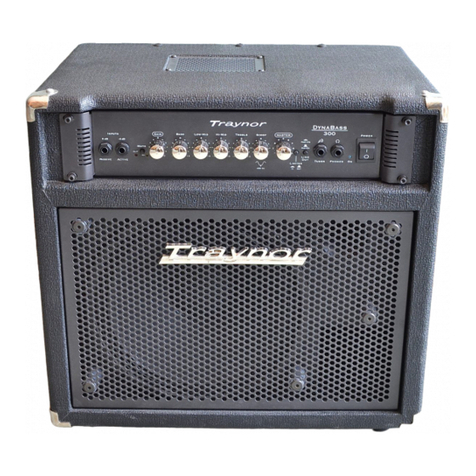
Traynor
Traynor DYNABASS 300 owner's manual
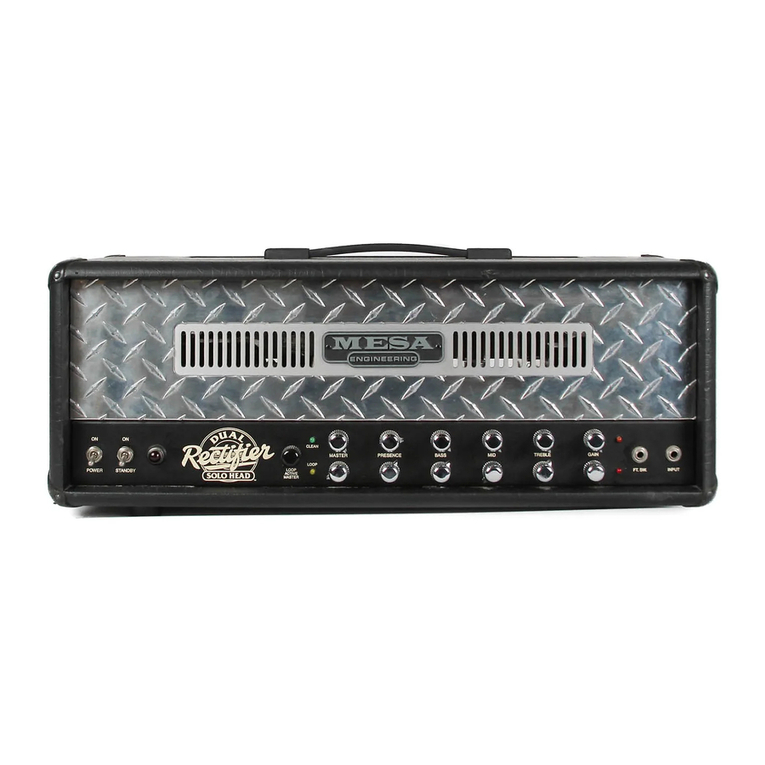
Mesa/Boogie
Mesa/Boogie Three Channel Dual & Triple Rectifier Solo... owner's manual
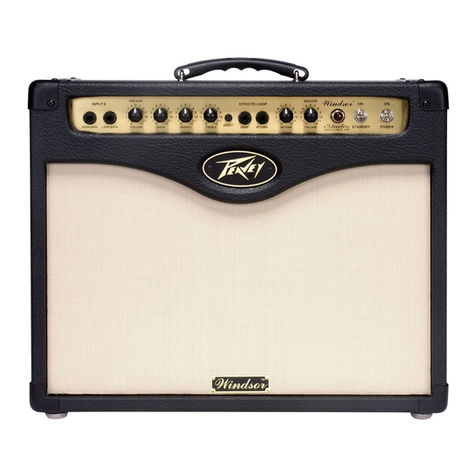
Peavey
Peavey Windsor WindsorTM Studio operating manual

Kustom
Kustom Sienna 30PRO quick start guide
